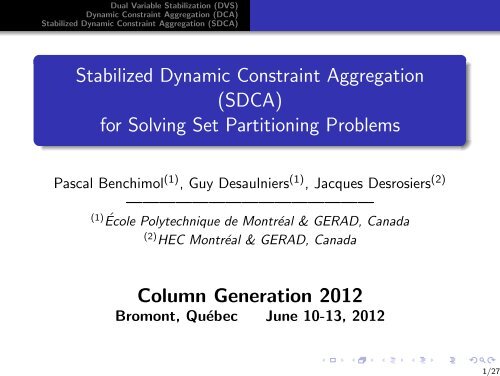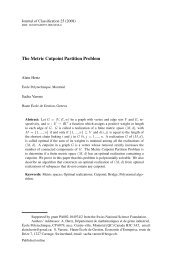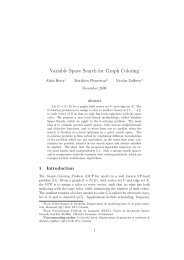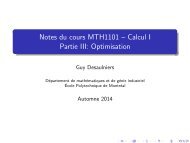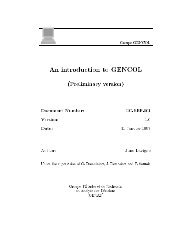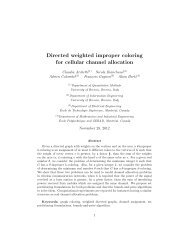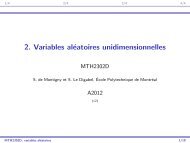Stabilized Dynamic Constraint Aggregation (SDCA) for ... - gerad
Stabilized Dynamic Constraint Aggregation (SDCA) for ... - gerad
Stabilized Dynamic Constraint Aggregation (SDCA) for ... - gerad
Create successful ePaper yourself
Turn your PDF publications into a flip-book with our unique Google optimized e-Paper software.
Dual Variable Stabilization (DVS)<strong>Dynamic</strong> <strong>Constraint</strong> <strong>Aggregation</strong> (DCA)<strong>Stabilized</strong> <strong>Dynamic</strong> <strong>Constraint</strong> <strong>Aggregation</strong> (<strong>SDCA</strong>)1/27<strong>Stabilized</strong> <strong>Dynamic</strong> <strong>Constraint</strong> <strong>Aggregation</strong>(<strong>SDCA</strong>)<strong>for</strong> Solving Set Partitioning ProblemsPascal Benchimol (1) , Guy Desaulniers (1) , Jacques Desrosiers (2)———————————————(1) École Polytechnique de Montréal & GERAD, Canada(2) HEC Montréal & GERAD, CanadaColumn Generation 2012Bromont, Québec June 10-13, 2012
Dual Variable Stabilization (DVS)<strong>Dynamic</strong> <strong>Constraint</strong> <strong>Aggregation</strong> (DCA)<strong>Stabilized</strong> <strong>Dynamic</strong> <strong>Constraint</strong> <strong>Aggregation</strong> (<strong>SDCA</strong>)2/271 Dual Variable Stabilization (DVS)2 <strong>Dynamic</strong> <strong>Constraint</strong> <strong>Aggregation</strong> (DCA)3 <strong>Stabilized</strong> <strong>Dynamic</strong> <strong>Constraint</strong> <strong>Aggregation</strong> (<strong>SDCA</strong>)
Dual Variable Stabilization (DVS)<strong>Dynamic</strong> <strong>Constraint</strong> <strong>Aggregation</strong> (DCA)<strong>Stabilized</strong> <strong>Dynamic</strong> <strong>Constraint</strong> <strong>Aggregation</strong> (<strong>SDCA</strong>)Primal-Dual pair of a linear problem3/27(P)minλs.t.∑c x λ x (1)x∈∆∑a x λ x = b [π ∈ R m ] (2)x∈∆λ x ≥ 0, ∀x ∈ ∆ (3)(D)maxππ ⊤ b (4)s.t. π ⊤ a x ≤ c x , ∀x ∈ ∆ (5)∆ is a finite set of combinatorial objects.Rows (or tasks) in (2) are indexed by t ∈ T := {1, . . . , m}.
Dual Variable Stabilization (DVS)<strong>Dynamic</strong> <strong>Constraint</strong> <strong>Aggregation</strong> (DCA)<strong>Stabilized</strong> <strong>Dynamic</strong> <strong>Constraint</strong> <strong>Aggregation</strong> (<strong>SDCA</strong>)Motivation4/27
Dual Variable Stabilization (DVS)<strong>Dynamic</strong> <strong>Constraint</strong> <strong>Aggregation</strong> (DCA)<strong>Stabilized</strong> <strong>Dynamic</strong> <strong>Constraint</strong> <strong>Aggregation</strong> (<strong>SDCA</strong>)Motivation5/27
6/27Dual Variable Stabilization (DVS)<strong>Dynamic</strong> <strong>Constraint</strong> <strong>Aggregation</strong> (DCA)<strong>Stabilized</strong> <strong>Dynamic</strong> <strong>Constraint</strong> <strong>Aggregation</strong> (<strong>SDCA</strong>)1.- Dual Variable Stabilization (DVS)du Merle et al. (1999), Oukil et al. (2007), Ben Amor et al. (2009)DVS penalizes a large portion of the dual solution space.A penalty function f t (π t ), ∀t ∈ T :continuous, concave, symmetric, and piecewise linear with 3 pieces.
Dual Variable Stabilization (DVS)<strong>Dynamic</strong> <strong>Constraint</strong> <strong>Aggregation</strong> (DCA)<strong>Stabilized</strong> <strong>Dynamic</strong> <strong>Constraint</strong> <strong>Aggregation</strong> (<strong>SDCA</strong>)Stabilization in the primal space7/27P εδ : A relaxation of the primal problem P ∆∑(P εδ ) min c x λ x − δ ⊤ −y − + δ ⊤ +y + (6)λ,yx∈∆∑s.t. a x λ x − y − + y + = b [π ∈ R m ] (7)x∈∆0 ≤ y − ≤ ε − [ω − ∈ R m ] (8)0 ≤ y + ≤ ε + [ω + ∈ R m ] (9)λ x ≥ 0, ∀x ∈ ∆ (10)
Dual Variable Stabilization (DVS)<strong>Dynamic</strong> <strong>Constraint</strong> <strong>Aggregation</strong> (DCA)<strong>Stabilized</strong> <strong>Dynamic</strong> <strong>Constraint</strong> <strong>Aggregation</strong> (<strong>SDCA</strong>)8/27To solve P, a sequence of linear approximations (relaxations), i.e.,stabilized problems P s (s ≥ 1) are solved with ε s and δ syielding objective values z 1 < z 2 < ... < z s < ... ≤ z ∗ .
Dual Variable Stabilization (DVS)<strong>Dynamic</strong> <strong>Constraint</strong> <strong>Aggregation</strong> (DCA)<strong>Stabilized</strong> <strong>Dynamic</strong> <strong>Constraint</strong> <strong>Aggregation</strong> (<strong>SDCA</strong>)8/27To solve P, a sequence of linear approximations (relaxations), i.e.,stabilized problems P s (s ≥ 1) are solved with ε s and δ syielding objective values z 1 < z 2 < ... < z s < ... ≤ z ∗ .
Dual Variable Stabilization (DVS)<strong>Dynamic</strong> <strong>Constraint</strong> <strong>Aggregation</strong> (DCA)<strong>Stabilized</strong> <strong>Dynamic</strong> <strong>Constraint</strong> <strong>Aggregation</strong> (<strong>SDCA</strong>)DVS algorithm9/271: Set s := 1 and choose stabilization parameters ε s and δ s .2: Solve stabilized problem P s : (λ s , y s ).3: if y s = 0 then4: Stop. λ s is optimal to P.5: else6: s := s + 1, update ε s and δ s , and return to Step 2.
Dual Variable Stabilization (DVS)<strong>Dynamic</strong> <strong>Constraint</strong> <strong>Aggregation</strong> (DCA)<strong>Stabilized</strong> <strong>Dynamic</strong> <strong>Constraint</strong> <strong>Aggregation</strong> (<strong>SDCA</strong>)2.- <strong>Dynamic</strong> <strong>Constraint</strong> <strong>Aggregation</strong> (DCA)<strong>for</strong> set partitioning problems10/27Let Q := {T l } l∈L be a partition of the rows of T into clusters.∑(P Q ) minc x λ x (11)λx∈∆ Q∑s.t.a Qx λ x = 1 [π Q ∈ R |L| ] (12)x∈∆ Qλ x ≥ 0, ∀x ∈ ∆ Q (13)column a Qx ∈ {0, 1} |L| is a clustered version of a x ∈ {0, 1} m :component a Qxl = 1 if object x selects cluster l ∈ L, 0 otherwise.
11/27Dual Variable Stabilization (DVS)<strong>Dynamic</strong> <strong>Constraint</strong> <strong>Aggregation</strong> (DCA)<strong>Stabilized</strong> <strong>Dynamic</strong> <strong>Constraint</strong> <strong>Aggregation</strong> (<strong>SDCA</strong>)Each subset of identical rows defines a cluster in QFrom an integer solution
11/27Dual Variable Stabilization (DVS)<strong>Dynamic</strong> <strong>Constraint</strong> <strong>Aggregation</strong> (DCA)<strong>Stabilized</strong> <strong>Dynamic</strong> <strong>Constraint</strong> <strong>Aggregation</strong> (<strong>SDCA</strong>)Each subset of identical rows defines a cluster in QFrom an integer solutionFrom a fractional solution
Dual Variable Stabilization (DVS)<strong>Dynamic</strong> <strong>Constraint</strong> <strong>Aggregation</strong> (DCA)<strong>Stabilized</strong> <strong>Dynamic</strong> <strong>Constraint</strong> <strong>Aggregation</strong> (<strong>SDCA</strong>)12/27To solve P, a sequence of row-aggregated problems P Qh (h ≥ 1)are solved with various row-partitions Q h ,yielding objective values z 1 ≥ z 2 ≥ ... ≥ z h ≥ ... ≥ z ∗ .
Dual Variable Stabilization (DVS)<strong>Dynamic</strong> <strong>Constraint</strong> <strong>Aggregation</strong> (DCA)<strong>Stabilized</strong> <strong>Dynamic</strong> <strong>Constraint</strong> <strong>Aggregation</strong> (<strong>SDCA</strong>)12/27To solve P, a sequence of row-aggregated problems P Qh (h ≥ 1)are solved with various row-partitions Q h ,yielding objective values z 1 ≥ z 2 ≥ ... ≥ z h ≥ ... ≥ z ∗ .A column generation processP is solved using various clusters until an equivalence with theoriginal problem.
Dual Variable Stabilization (DVS)<strong>Dynamic</strong> <strong>Constraint</strong> <strong>Aggregation</strong> (DCA)<strong>Stabilized</strong> <strong>Dynamic</strong> <strong>Constraint</strong> <strong>Aggregation</strong> (<strong>SDCA</strong>)12/27To solve P, a sequence of row-aggregated problems P Qh (h ≥ 1)are solved with various row-partitions Q h ,yielding objective values z 1 ≥ z 2 ≥ ... ≥ z h ≥ ... ≥ z ∗ .A column generation processP is solved using various clusters until an equivalence with theoriginal problem.λ Qhis optimal to P ifthere is no negative reduced cost variableswith respect to some disaggregated dual vector π ∈ R m .
Dual Variable Stabilization (DVS)<strong>Dynamic</strong> <strong>Constraint</strong> <strong>Aggregation</strong> (DCA)<strong>Stabilized</strong> <strong>Dynamic</strong> <strong>Constraint</strong> <strong>Aggregation</strong> (<strong>SDCA</strong>)DCA algorithm <strong>for</strong> set partitioning problems13/271: Select a row-partition Q.2: Solve row-aggregated problem P Q : (λ Q ; π Q ).3: Disaggregate the dual vector π Q to compute π ∈ R m .4: Check if there exist negative reduced cost variables.5: if no such variables exist then6: Stop. λ Q is optimal <strong>for</strong> P.7: else8: Update Q using a few negative reduced cost variables,and return to Step 2.(Each subset of identical rows defines a cluster.)
Dual Variable Stabilization (DVS)<strong>Dynamic</strong> <strong>Constraint</strong> <strong>Aggregation</strong> (DCA)<strong>Stabilized</strong> <strong>Dynamic</strong> <strong>Constraint</strong> <strong>Aggregation</strong> (<strong>SDCA</strong>)Dual variable disaggregation <strong>for</strong> set partitioning problems14/27A sufficient condition:∑t∈T lπ t = π Ql , ∀l ∈ L. (14)
Dual Variable Stabilization (DVS)<strong>Dynamic</strong> <strong>Constraint</strong> <strong>Aggregation</strong> (DCA)<strong>Stabilized</strong> <strong>Dynamic</strong> <strong>Constraint</strong> <strong>Aggregation</strong> (<strong>SDCA</strong>)Dual variable disaggregation <strong>for</strong> set partitioning problems14/27A sufficient condition:∑t∈T lπ t = π Ql , ∀l ∈ L. (14)Incompatible variables in ∆ ¯Q1 and ∆ ¯Q2 (Elhallaoui et al. 2005)Since the sum of the dual variables in cluster l is known by (14),the non-negativity constraints on the reduced costs of variables λ x ,x ∈ ∆ ¯Q 1∪ ∆ ¯Q 2, can be trans<strong>for</strong>med into difference inequalities,i.e., the disaggregation is the solution of a shortest path problem.An incompatible column in ∆ ¯Q1 partially covers a single clusterwhereas a column in ∆ ¯Q 2is incompatible with two.
Dual Variable Stabilization (DVS)<strong>Dynamic</strong> <strong>Constraint</strong> <strong>Aggregation</strong> (DCA)<strong>Stabilized</strong> <strong>Dynamic</strong> <strong>Constraint</strong> <strong>Aggregation</strong> (<strong>SDCA</strong>)Results-1: DVS dominates standard CG and DCA15/27
Dual Variable Stabilization (DVS)<strong>Dynamic</strong> <strong>Constraint</strong> <strong>Aggregation</strong> (DCA)<strong>Stabilized</strong> <strong>Dynamic</strong> <strong>Constraint</strong> <strong>Aggregation</strong> (<strong>SDCA</strong>)Results-1: DVS dominates standard CG and DCA15/27cpu DCAcpu DVScpu CGcpu DCAcpu DVScpu CGcpu DVSTasks Dayscpu DVSTasks Days5005.53 6.06 50061.28 48.67251000 5.84 8.26 1000 67.45 463.17Average 5.68 7.16 Average 64.37 255.92Table: CPU time ratios of standard CG and DCA over DVS
Dual Variable Stabilization (DVS)<strong>Dynamic</strong> <strong>Constraint</strong> <strong>Aggregation</strong> (DCA)<strong>Stabilized</strong> <strong>Dynamic</strong> <strong>Constraint</strong> <strong>Aggregation</strong> (<strong>SDCA</strong>)3.- <strong>Stabilized</strong> <strong>Dynamic</strong> <strong>Constraint</strong> <strong>Aggregation</strong>:integration of DCA within DVS to reduce MP cpu16/27
Dual Variable Stabilization (DVS)<strong>Dynamic</strong> <strong>Constraint</strong> <strong>Aggregation</strong> (DCA)<strong>Stabilized</strong> <strong>Dynamic</strong> <strong>Constraint</strong> <strong>Aggregation</strong> (<strong>SDCA</strong>)3.- <strong>Stabilized</strong> <strong>Dynamic</strong> <strong>Constraint</strong> <strong>Aggregation</strong>:integration of DCA within DVS to reduce MP cpu16/27DVS2500major iterations1 10 20 30 40420002cpu (sec.)150010000-2-4-6distance to optimal value500-800 50 100 150 200 250 300 350minor iterations-10cpu RMPcpu SPobjectiveFigure:DVS <strong>for</strong> a 2500-task, 5-day scenario
Dual Variable Stabilization (DVS)<strong>Dynamic</strong> <strong>Constraint</strong> <strong>Aggregation</strong> (DCA)<strong>Stabilized</strong> <strong>Dynamic</strong> <strong>Constraint</strong> <strong>Aggregation</strong> (<strong>SDCA</strong>)<strong>SDCA</strong>: <strong>Stabilized</strong> & row-aggregated problem17/27P s → PQsε s −, ε s +, δ−, s δ+, s y−, s y+ s → ε s Q− , εs Q+ , δs Q− , δs Q+ , y Q− s , y Q+s—————————————————————————PQ s → P s(λ s Q , ys Q , zs ) → (λ s , y s , z s )(π s Q , ωs Q , zs ) → (π s , ω s , z s )
Dual Variable Stabilization (DVS)<strong>Dynamic</strong> <strong>Constraint</strong> <strong>Aggregation</strong> (DCA)<strong>Stabilized</strong> <strong>Dynamic</strong> <strong>Constraint</strong> <strong>Aggregation</strong> (<strong>SDCA</strong>)<strong>SDCA</strong>: <strong>Stabilized</strong> & row-aggregated problem18/27Proposition 2Row-aggregated parameters: P s → P s QFor all l ∈ Lε s Q−,l := min t∈T l{ε s −,t},δ s Q−,l := ∑ t∈T lδ s −,t,ε s Q+,l := min t∈T l{ε s +,t};δ s Q+,l := ∑ t∈T lδ s +,t<strong>Stabilized</strong> primal solution: P s Q→ P sλ s x := λ s Qx , ∀x ∈ ∆ Qλ s x := 0, ∀x ∈ ∆ \ ∆ Qy s −,t := y s Q−,l and y s +,t := y s Q+,l , ∀t ∈ T l, l ∈ L,
Dual Variable Stabilization (DVS)<strong>Dynamic</strong> <strong>Constraint</strong> <strong>Aggregation</strong> (DCA)<strong>Stabilized</strong> <strong>Dynamic</strong> <strong>Constraint</strong> <strong>Aggregation</strong> (<strong>SDCA</strong>)<strong>SDCA</strong>: Dual variable disaggregation19/27Define β s l,i :=i∑πl,j s ,j=1∀l ∈ L, i ∈ {1, . . . , |T l|}.The system of difference inequalities takes into account, <strong>for</strong> eachconstraint t ∈ T , the trust region carried out by the δ-parameters.β s l,|T l | = πs Q,l ,∀l ∈ Lβ s l,i − βs l,i−1 ≥ δs −,t, ∀t = (l, i) ∈ T such that y s −,t = 0βl,i s − βs l,i−1 = δs −,t, ∀t = (l, i) ∈ T such that 0 < y−,t s < ε s −,tβl,i s − βs l,i−1 ≤ δs −,t, ∀t = (l, i) ∈ T such that y−,t s = ε s −,tβl,i s − βs l,i−1 ≤ δs +,t, ∀t = (l, i) ∈ T such that y+,t s = 0β s l,i − βs l,i−1 = δs +,t,β s l,i − βs l,i−1 ≥ δs +,t,∀t = (l, i) ∈ T such that 0 < y+,t s < ε s +,t∀t = (l, i) ∈ T such that y+,t s = ε s +,t.Still solvable as a shortest path problem.
Dual Variable Stabilization (DVS)<strong>Dynamic</strong> <strong>Constraint</strong> <strong>Aggregation</strong> (DCA)<strong>Stabilized</strong> <strong>Dynamic</strong> <strong>Constraint</strong> <strong>Aggregation</strong> (<strong>SDCA</strong>)Results-3: DVS vs. <strong>SDCA</strong>20/27<strong>SDCA</strong>2500major iterations1 10 20 30 40420002cpu (sec.)150010000-2-4-6distance to optimal value500-800 50 100 150 200 250 300 350minor iterations-10cpu RMPcpu SPobjectiveFigure: <strong>SDCA</strong> <strong>for</strong> a 2500-task, 5-day scenario
Dual Variable Stabilization (DVS)<strong>Dynamic</strong> <strong>Constraint</strong> <strong>Aggregation</strong> (DCA)<strong>Stabilized</strong> <strong>Dynamic</strong> <strong>Constraint</strong> <strong>Aggregation</strong> (<strong>SDCA</strong>)Computational Experiments21/27<strong>Stabilized</strong> <strong>Dynamic</strong> <strong>Constraint</strong> <strong>Aggregation</strong> (<strong>SDCA</strong>)within Column GenerationSet Partitioning model <strong>for</strong> the MDVSP.Random instances using the procedure of Carpaneto et al. (1989),modified by Oukil et al. (2007) to adjust the level of degeneracy.3 depots and between 500 and 3000 tasks spread over 2 or 5 days.5-day instances are highly degenerate.For each row-size, reported results are average over 6 instances.
Dual Variable Stabilization (DVS)<strong>Dynamic</strong> <strong>Constraint</strong> <strong>Aggregation</strong> (DCA)<strong>Stabilized</strong> <strong>Dynamic</strong> <strong>Constraint</strong> <strong>Aggregation</strong> (<strong>SDCA</strong>)Computational Experiments21/27<strong>Stabilized</strong> <strong>Dynamic</strong> <strong>Constraint</strong> <strong>Aggregation</strong> (<strong>SDCA</strong>)within Column GenerationSet Partitioning model <strong>for</strong> the MDVSP.Random instances using the procedure of Carpaneto et al. (1989),modified by Oukil et al. (2007) to adjust the level of degeneracy.3 depots and between 500 and 3000 tasks spread over 2 or 5 days.5-day instances are highly degenerate.For each row-size, reported results are average over 6 instances.** Initial primal & dual solutions: MDVSP relaxed as a SDVSP.** Barycenter initial dual estimate (Rousseau et al. 2007)
Dual Variable Stabilization (DVS)<strong>Dynamic</strong> <strong>Constraint</strong> <strong>Aggregation</strong> (DCA)<strong>Stabilized</strong> <strong>Dynamic</strong> <strong>Constraint</strong> <strong>Aggregation</strong> (<strong>SDCA</strong>)Results-3: DVS vs. <strong>SDCA</strong> (MP CPU)22/272-day scenario5-day scenarioTrips DVS <strong>SDCA</strong> Rows (%) DVS <strong>SDCA</strong> Rows (%)500 7 4 84.2 7 3 71.91000 31 13 85.3 33 10 69.71500 109 44 85.6 109 20 68.82000 225 70 85.3 278 70 67.42500 471 136 85.2 575 89 69.73000 838 224 87.1 1160 159 68.9Total 1681 491 2162 350Table: Average Master Problem CPU time (sec)———————————Master Problem CPU times reduced by factors 3 and 7 vs. DVS.Row reduction to around 85% and 70%.<strong>SDCA</strong> robust with regard to increasing levels of degeneracy.
Dual Variable Stabilization (DVS)<strong>Dynamic</strong> <strong>Constraint</strong> <strong>Aggregation</strong> (DCA)<strong>Stabilized</strong> <strong>Dynamic</strong> <strong>Constraint</strong> <strong>Aggregation</strong> (<strong>SDCA</strong>)References23/27DVS: Dual Variable StabilizationO. du Merle, D. Villeneuve, J. Desrosiers, and P. Hansen.<strong>Stabilized</strong> column generation.Discrete Mathematics, 194(1-3):229–237, 1999.doi:10.1016/S0012-365X(98)00213-1A. Oukil, H. Ben Amor, J. Desrosiers, and H. Elgueddari.<strong>Stabilized</strong> column generation <strong>for</strong> highly degenerate multiple-depotvehicle scheduling problems.Computers & Operations Research, 34(3):817–834, 2007.doi:10.1016/j.cor.2005.05.011H.M.T. Ben Amor, J. Desrosiers, and A. Frangioni.On the choice of explicit stabilizing terms in column generation.Discrete Applied Mathematics, 157(6):1167–1184, 2009.doi:10.1016/j.dam.2008.06.021L.-M. Rousseau, M. Gendreau, and D. Feillet.Interior point stabilization <strong>for</strong> column generation.Operations Research Letters, 35(5):660–668, 2007.doi:org/10.1016/j.orl.2006.11.004
Dual Variable Stabilization (DVS)<strong>Dynamic</strong> <strong>Constraint</strong> <strong>Aggregation</strong> (DCA)<strong>Stabilized</strong> <strong>Dynamic</strong> <strong>Constraint</strong> <strong>Aggregation</strong> (<strong>SDCA</strong>)References24/27DCA: <strong>Dynamic</strong> <strong>Constraint</strong> <strong>Aggregation</strong>I. Elhallaoui, D. Villeneuve, F. Soumis, and G. Desaulniers.<strong>Dynamic</strong> aggregation of set partitioning constraints in columngeneration.Operations Research, 53(4):632-645, 2005.doi: 10.1287/opre.1050.0222.I. Elhallaoui, G. Desaulniers, A. Metrane, and F. Soumis.Bi-dynamic constraint aggregation and subproblem reduction.Computers & Operations Research, 35(5):1713-1724, 2008.doi: 10.1016/j.cor.2006.10.007.I. Elhallaoui, A. Metrane, F. Soumis, and G. Desaulniers.Multi-phase dynamic constraint aggregation <strong>for</strong> set partitioning typeproblems.Mathematical Programming, 123(2):345-370, 2010.doi: 10.1007/s10107-008-0254-5.
Dual Variable Stabilization (DVS)<strong>Dynamic</strong> <strong>Constraint</strong> <strong>Aggregation</strong> (DCA)<strong>Stabilized</strong> <strong>Dynamic</strong> <strong>Constraint</strong> <strong>Aggregation</strong> (<strong>SDCA</strong>)References25/27<strong>SDCA</strong>: <strong>Stabilized</strong> <strong>Dynamic</strong> <strong>Constraint</strong> <strong>Aggregation</strong>P. Benchimol, G. Desaulniers, and J. Desrosiers.<strong>Stabilized</strong> dynamic constraint aggregation <strong>for</strong> solving setpartitioning problems.Les Cahiers du GERAD, G-2011-56, 26 pages, 2011.IPS: Improved Primal SimplexV. Raymond, F. Soumis, and D. Orban.A new version of the improved primal simplex <strong>for</strong> degenerate linearprograms.Computers & Operations Research, 37(1):91–98, 2010.
Dual Variable Stabilization (DVS)<strong>Dynamic</strong> <strong>Constraint</strong> <strong>Aggregation</strong> (DCA)<strong>Stabilized</strong> <strong>Dynamic</strong> <strong>Constraint</strong> <strong>Aggregation</strong> (<strong>SDCA</strong>)26/27<strong>SDCA</strong>2500major iterations1 10 20 30 40420002cpu (sec.)150010000-2-4-6distance to optimal value500-800 50 100 150 200 250 300 350minor iterations-10cpu RMPcpu SPobjectiveFigure: <strong>SDCA</strong> <strong>for</strong> a 2500-task, 5-day scenario
Dual Variable Stabilization (DVS)<strong>Dynamic</strong> <strong>Constraint</strong> <strong>Aggregation</strong> (DCA)<strong>Stabilized</strong> <strong>Dynamic</strong> <strong>Constraint</strong> <strong>Aggregation</strong> (<strong>SDCA</strong>)Results-3: DVS vs. <strong>SDCA</strong> (Total CPU)27/27Tasks Days DVS <strong>SDCA</strong> Tasks Days DVS <strong>SDCA</strong>50020 21 50020 181000 126 126 1000 113 951500 380 342 1500 376 280252000 776 677 2000 859 6532500 1403 1138 2500 1683 11383000 2401 1942 3000 3035 1914Total 5106 4246 Total 6086 4098Table: Average Total CPU time (sec)


